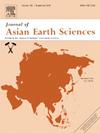Differential geological responses and geodynamic mechanisms of major Cenozoic tectonic Movements in the East China Sea Shelf basin
IF 2.7
3区 地球科学
Q2 GEOSCIENCES, MULTIDISCIPLINARY
引用次数: 0
Abstract
The East China Sea Shelf Basin (ECSSB) underwent complex tectonic evolution during the Cenozoic, shaped by interactions with surrounding geotectonic processes. This study examines six key tectonic interfaces (T80, T50, T40, T20, T12, T10) using 2D seismic data to assess their characteristics, distribution, and genesis. The T80 interface marks the transition of the Changjiang Depression into a post-rift stage, driven by the initial subduction of the Pacific-Izanagi ridge. Subsequent ridge subduction formed the T50 interface, characterized by magmatic activity, compression, uplift, and the deposition of large alluvial fans in northern ECSSB. The T40 interface, formed during the breakup of the South China Sea, is associated with widespread erosion and a significant hiatus in the southern ECSSB. The T20 interface reflects the initial subduction of the Philippine Sea Plate, triggering magmatic belt migration and uplift in the Diaoyu Island Fold Zone. The T12 interface highlights lateral compression linked to the early rifting of the Okinawa Trough, forming a central anticline in the Xihu Sag. Finally, the T10 interface, caused by arc-continent collision, contributed to deltaic deposition in the southeastern basin. These interfaces exhibit significant spatiotemporal variations, revealing the interplay between subduction, rifting, compression, and uplift. This study refines the understanding of tectonic phases in the ECSSB. The findings provide new perspectives on the basin’s geological complexity, contributing to broader knowledge of West Pacific geodynamics and basin evolution.
求助全文
约1分钟内获得全文
求助全文
来源期刊

Journal of Asian Earth Sciences
地学-地球科学综合
CiteScore
5.90
自引率
10.00%
发文量
324
审稿时长
71 days
期刊介绍:
Journal of Asian Earth Sciences has an open access mirror journal Journal of Asian Earth Sciences: X, sharing the same aims and scope, editorial team, submission system and rigorous peer review.
The Journal of Asian Earth Sciences is an international interdisciplinary journal devoted to all aspects of research related to the solid Earth Sciences of Asia. The Journal publishes high quality, peer-reviewed scientific papers on the regional geology, tectonics, geochemistry and geophysics of Asia. It will be devoted primarily to research papers but short communications relating to new developments of broad interest, reviews and book reviews will also be included. Papers must have international appeal and should present work of more than local significance.
The scope includes deep processes of the Asian continent and its adjacent oceans; seismology and earthquakes; orogeny, magmatism, metamorphism and volcanism; growth, deformation and destruction of the Asian crust; crust-mantle interaction; evolution of life (early life, biostratigraphy, biogeography and mass-extinction); fluids, fluxes and reservoirs of mineral and energy resources; surface processes (weathering, erosion, transport and deposition of sediments) and resulting geomorphology; and the response of the Earth to global climate change as viewed within the Asian continent and surrounding oceans.
 求助内容:
求助内容: 应助结果提醒方式:
应助结果提醒方式:


